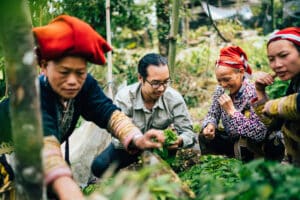SBC101 case
Introduction
In recent years, the growth rate of Vietnam’s agricultural exports is quite high, but not commensurate with the potential, efficiency, and low competitiveness. Several export agricultural products of Vietnam have accounted for high rankings in export volume, but cannot determine the price, even being forced to price. (Phạm, 2010: 67) That poses a great challenge to be able to create export products for Vietnam that have high value and are accepted by the world.
In that context, Song Cai was born in 2018 to raise the bar for Vietnamese exports by creating its brand with the cultural identity of Vietnam toward sustainable development and applying science and technology to cooperate in production and export, thereby suggesting a new model for businesses that both want to create social impact and want to export to enhance their business.
This research by our team will focus on analyzing how Sông Cái has come up with a brand imbued with cultural identity thereby creating positive impacts on society by exporting refined agricultural products of Vietnam.
Main content
-
Export status of Vietnam
Although it is an agricultural and export-focused country, Vietnam’s exports of high-quality agricultural products are few, most of which have not fully met international standards, so economic efficiency is low. Reports also show that Vietnam focuses on exporting raw agricultural products such as rice (ranked 2nd in the world in 2008), coffee (also ranked 2nd in the world in 2008), rubber, cashew, tea, cocoa, and fresh seafood (Phạm, 2010). This is mainly explained by the fact that most Vietnamese enterprises only focus on production and prioritize exporting in large quantities without focusing on product refining. Studies show that Vietnamese exports face many problems such as unattractive packaging, and not yet built a brand name. About 90% of agricultural and aquatic products exported in Vietnam do not have a brand. (Phạm, 2010:71). Therefore, the price of agricultural products for export in Vietnam is not stable, many “key” agricultural products for export have been seriously reduced in price (Phạm, 2010: 70).
-
Solutions to raise the value of Vietnam’s exports
Experts pointed out that to raise the value of Vietnam’s exports, we need to focus on promoting product refinement by promoting post-harvest technology and bringing new technologies into production and harvesting, preservation, processing, transportation, and consumption of agricultural products, application of clean technology in farming and processing vegetables and food. (Phạm, 2010: 71; Nguyễn, 2014: 42). At the same time, focusing on the branding of Vietnamese agricultural products is also considered a necessary solution to contribute to increasing the selling price of agricultural products in the international market. (Phạm, 2010: 72). Moreover, it is necessary to carry out linkages and cooperation in production and business. Currently, the association and cooperation in production and business are very weak in the production and export of agricultural products in Vietnam. This link includes farming in agriculture and in processing agricultural products for export, between processing agricultural products for export and other industries as well as infrastructure sectors, between domestic enterprises and foreign enterprises. (Nguyễn, 2014: 43). And especially important is the need to apply technology in production to increase the value of exports (Tô, 2015).
-
The Story of Sông Cái
Established in 2018 in Hanoi, Sông Cái Distillery is Vietnam’s first gin distillery aimed at exporting to Europe and North America markets. We can easily see information about Sông Cái on their website, which is a very eye-catching design with profound content, and clear illustrations, specifically in English, aimed at the international audience. Not stopping there, we can see that Sông Cái has received a lot of appreciation from international guests such as the introductions of independent authors in Food and Wine magazine and especially The New York Times Magazine (Dao, 2021 & Fabricant, 2021).
Sông Cái has inherited the success of Vietnam’s agricultural export industry but improved by branding and refining products to increase the quality of Vietnamese exports and mark a new export trend for Vietnam: refined goods have a clear brand name and are the product of multi-party cooperation thereby bringing Vietnamese culture to the world in a profound way.

Sông Cái leader participate in the selection of ingredients with the Dao women.
Focusing solely on gin branding, Sông Cái focuses on producing handcrafted gin in small batches in a direct copper kiln, delivering a rich, complex, and exceptionally well-rounded flavor. The plants used by Sông Cái are all rare and precious medicines of the ethnic groups of Vietnam as Dao, Hmong, Tay, and Kinh, thereby creating a sustainable and rich conservation in terms of environment, society, and culture. Sông Cái’s bottle label is inspired by Hàng Trống, an ancient painting style originating from Vietnam. Sông Cái Distillery worked with local designers and consulted with Mr. Lê Đình Nghiên, the last remaining Hàng Trống artisan, to incorporate these motifs into each bottle. From cultivation to distillation to bottling, every step of the process is driven by cultural pride. Sông Cái Distillery hopes to broaden its founding horizons by encouraging other Vietnamese entrepreneurs to create quality products that honor the country’s agricultural heritage.

Sông Cái bottle label is using Hàng Trống art.
Song Cai also has the advantage of understanding the European and North American markets as the founder is a Ph.D. student in biodiversity and ethnic flora in Vietnamese America and has many years of experience working in the United States, and also in the agricultural production and export system of Vietnam.
Sông Cái is very focused on collaboration between groups of people: the production team is mountainous farmers, and the refining team is well-trained experts in well-researched laboratories. The success of this brand is not only the story of the distillery experts but also their ability to tell profound cultural stories through the way they do it. With the brand representing “mother river” (Cái means big, mother in Vietnamese), Sông Cái has quickly become a partner of more than 70 indigenous families. That proves that Sông Cái is not only an export business, but also a social impact business when prioritizing sustainable development in terms of environment, culture, and community. Sông Cái also focuses on a multitude of community initiatives ranging from literary programs to seed databases and re-propagation projects that will contribute to long-term development. “Our path is one of intersections and overlaps like water flowing from the mountains. Never be confined to just one road, one creek. Thereby, they were drawn to the guiding principles of ethnographic botany: that land, people, and culture are interconnected. To care about one is to care about the other.” (2023).
Conclusion
In the context of Vietnam’s export agricultural products facing many difficulties and challenges when focusing only on output and forgetting about sustainability stories about culture, environment, and community, Sông Cái emerges as a representative for a new trend: focusing on building a strong brand identity and aiming for sustainable development. The success of Sông Cái not only brings glory to Vietnam’s export agriculture but also the affirmation of refined agricultural products – namely, gin of Southeast Asia (Dao, 2021), as shared by Sông Cái founder Daniel Hoai Nguyen shared: “Our gin is simply more indicative of the unique Vietnamese palate: The juniper berry is not as pronounced, we’re lighter on the profiles of angelica root, and our citrus is a variety of pomelo that is endemic to Vietnam. We use what’s important to the Vietnamese.” (Dao, 2021).
References
Dao, D. Q. (2021, April 1). This terroir-driven gin captures the spirit of Vietnam. Food & Wine. Retrieved May 1, 2023, from https://www.foodandwine.com/cocktails-spirits/gin/vietnamese-gin-song-cai-distillery
Fabricant, F. (2021, October 11). Gin with a hint of Mangosteen. The New York Times. Retrieved May 1, 2023, from https://www.nytimes.com/2021/10/11/dining/drinks/song-cai-gin-vietnam.html
The first Vietnamese gin. Sông Cái Distillery. (n.d.). Retrieved May 1, 2023, from https://www.songcaidistillery.com/our-story
Nguyễn, L. T. P. (2014). Xuất khẩu nông sản chế biến của Thái Lan và bài học cho Việt Nam. Retrieved May 1, 2023, from http://vci.vnu.edu.vn/upload/15022/pdf/576365157f8b9a1ec78b456b.pdf
Phạm, T. T. X. (2010). Nông sản xuất khẩu Việt Nam trong thời kỳ hội nhập: Thực trạng và giải pháp phát triển. Retrieved May 1, 2023, from http://vci.vnu.edu.vn/upload/15022/pdf/576382277f8b9a865a8b4581.pdf
Sông Cái Distillery. (2021, August 17). Sông Cái Distillery: The first gin from Việt Nam. YouTube. Retrieved May 1, 2023, from https://www.youtube.com/watch?v=myZLTL9B7uM
Tô, H. T. K. (2015). Cái tiến công nghệ để giúp nông sản Việt Nam vượt qua các rào cản quốc tế. tailieu.vn. Retrieved May 1, 2023, from https://tailieu.vn/doc/cai-tien-cong-nghe-de-giup-nong-san-viet-nam-vuot-qua-cac-rao-can-thuong-mai-quoc-te-2035111.html

